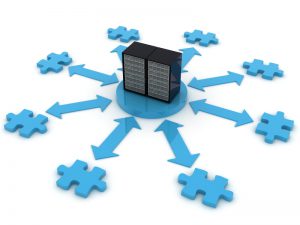During the last two weeks, an unprecedented number of cyber attacks swept the globe leaving organizations across every industry scrambling to recover. In the U.K., 16 National Health Service  facilities were affected by ransomware known as “WannaCry” forcing them to divert emergency room patients to unaffected hospitals. In Spain, the same malware hit one of the country’s largest telecommunications companies to the point where employees were notified to shut down systems in order to prevent the malware from spreading further. Even the global delivery giant FedEx was impacted, admitting in a statement to NBC News, “like many other companies, FedEx is experiencing interference with some of our Windows-based systems caused by malware. We are implementing remediation steps as quickly as possible.”
facilities were affected by ransomware known as “WannaCry” forcing them to divert emergency room patients to unaffected hospitals. In Spain, the same malware hit one of the country’s largest telecommunications companies to the point where employees were notified to shut down systems in order to prevent the malware from spreading further. Even the global delivery giant FedEx was impacted, admitting in a statement to NBC News, “like many other companies, FedEx is experiencing interference with some of our Windows-based systems caused by malware. We are implementing remediation steps as quickly as possible.”
This attack comes on the heels of tech giant Google disclosing details on an attack that was launched affecting its Google Docs application. This attack was effective in that it actually took advantage of legitimate authentication protocols that can result in granting full permissions to the attacker to email and other connected accounts. Google quickly shut down the incident, but not before users were already affected.
More Attacks to Come
The U.S. Computer Emergency Response Team issued an alert Friday afternoon warning organizations to be on the lookout for more WannaCry attacks. The New York Times is reporting that the exploit for WannaCry software was stolen from the National Security Agency. This malware was identified across 74 countries. While U.S. government officials have not confirmed that the NSA lost these tools, it’s safe to say that in the wake of the attacks seen over the last couple weeks, companies of all sizes need to be on the alert. Ironically, these events happen at the same time that the White House released an executive order requiring federal agencies to adopt the NIST Cybersecurity Framework controls.
Plan, Protect and Prevail
While all of this can be extremely scary, the good news is, with the right security controls, it’s possible to defend against these attacks. Arraya’s Cyber Security Practice is well versed in deploying ransomware defense technologies and strategies. Our Vulnerability Management Services and framework gap assessments are specifically targeted towards defending against the kinds of threats unveiled in the last week. Additionally, Arraya’s security incident and event management solutions combined with advisory services like training and awareness, incident response planning, and disaster recovery options arm companies with the tools they need to combat advanced persistent threats and recover quickly in the event catastrophe does strike.
Arraya’s Cyber Security Expertise
Many companies want to leverage best in class security expertise without the burden of building an entire security staff from the ground up. Arraya’s Cyber Security Practice offers businesses the ability to do just that. Arraya’s Advisory Services enable organizations to gain the expertise of a seasoned CISO, at a fraction of the cost of hiring one. Additionally, Arraya’s Cyber Security Advisory Services can work across departments and organizational roles to develop world-class, holistic security solutions. To find out more, contact us at: https://www.arrayasolutions.com//contact-us/.
 attempting to rectify the situation. It’s also plenty of time to give customers a negative experience that can take longer – and cost far more – to undo.
attempting to rectify the situation. It’s also plenty of time to give customers a negative experience that can take longer – and cost far more – to undo. than directly stealing money, attacks may focus on disabling systems and causing damage to critical infrastructure. Criminals may also have their eyes on intellectual property or internal operational information as part of a corporate espionage campaign. Motivation aside, the aftermath is no less painful.
than directly stealing money, attacks may focus on disabling systems and causing damage to critical infrastructure. Criminals may also have their eyes on intellectual property or internal operational information as part of a corporate espionage campaign. Motivation aside, the aftermath is no less painful. operations for the rest of the company. And while Gartner reports that
operations for the rest of the company. And while Gartner reports that  meant overhauling on-premises infrastructure to support that new initiative. Thanks to modern advances like the cloud and hybrid data centers, companies can transform on the fly. Major innovation can be triggered with little more than a credit card.
meant overhauling on-premises infrastructure to support that new initiative. Thanks to modern advances like the cloud and hybrid data centers, companies can transform on the fly. Major innovation can be triggered with little more than a credit card. covers hardware, software, and associated services. Considering the value mobile workforces bring to businesses, this investment does make sense. However, from IT’s perspective, it presents certain challenges.
covers hardware, software, and associated services. Considering the value mobile workforces bring to businesses, this investment does make sense. However, from IT’s perspective, it presents certain challenges. compliance as a means to justify security spending and initiatives. It can be difficult in some cases to know exactly what you are required to do. Sometimes regulations are very direct and clear, while, in other instances, regulations can be risk-based and subjective. It’s always fun sitting in a room with legal, IT, and compliance and trying to build a plan on
compliance as a means to justify security spending and initiatives. It can be difficult in some cases to know exactly what you are required to do. Sometimes regulations are very direct and clear, while, in other instances, regulations can be risk-based and subjective. It’s always fun sitting in a room with legal, IT, and compliance and trying to build a plan on  no longer feature the backup and recovery solution. Naturally, customers who count on vSphere Data Protection to defend their virtualized data are going to have a few concerns as it pertains to this decision.
no longer feature the backup and recovery solution. Naturally, customers who count on vSphere Data Protection to defend their virtualized data are going to have a few concerns as it pertains to this decision. long time. However, in recent years, a number of challengers have appeared to test their dominance. Among the latest is Cisco’s Spark Board, a device that
long time. However, in recent years, a number of challengers have appeared to test their dominance. Among the latest is Cisco’s Spark Board, a device that